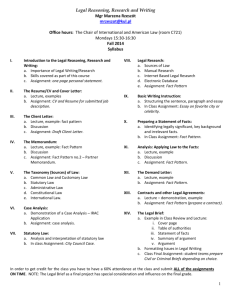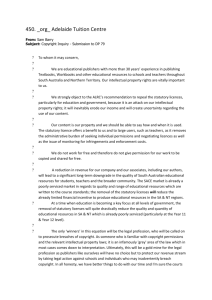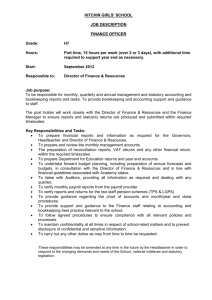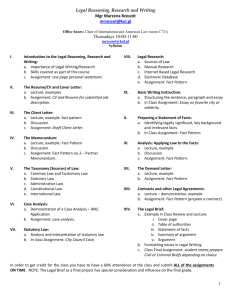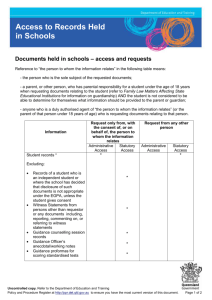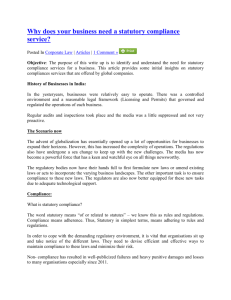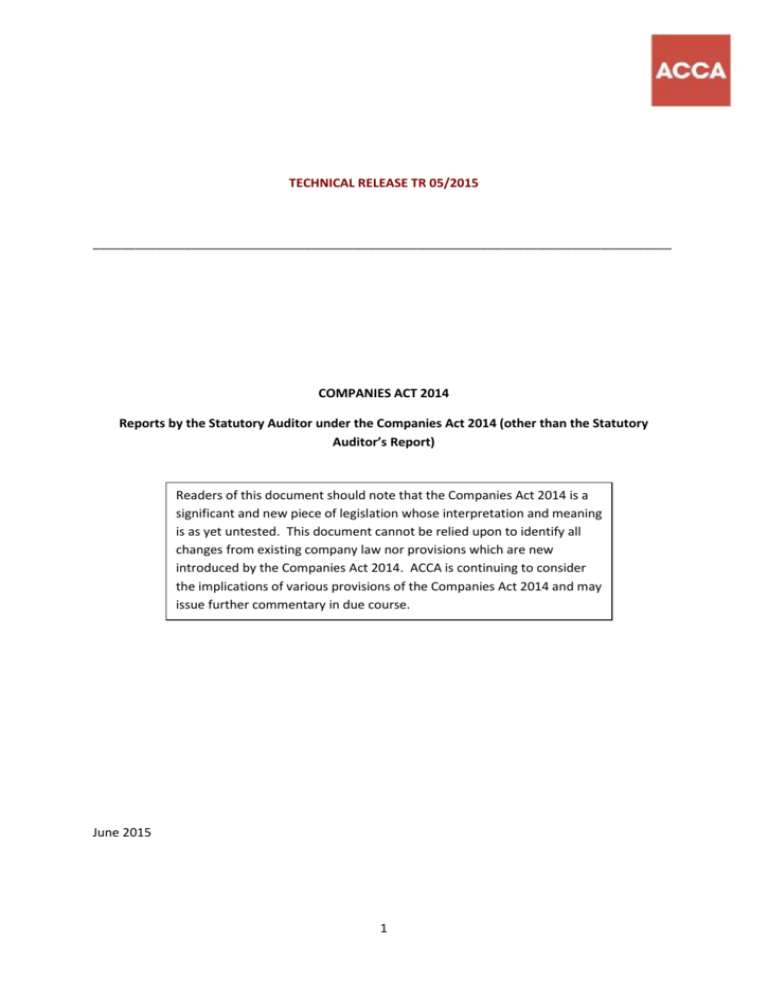
TECHNICAL RELEASE TR 05/2015
__________________________________________________________________________________
COMPANIES ACT 2014
Reports by the Statutory Auditor under the Companies Act 2014 (other than the Statutory
Auditor’s Report)
Readers of this document should note that the Companies Act 2014 is a
significant and new piece of legislation whose interpretation and meaning
is as yet untested. This document cannot be relied upon to identify all
changes from existing company law nor provisions which are new
introduced by the Companies Act 2014. ACCA is continuing to consider
the implications of various provisions of the Companies Act 2014 and may
issue further commentary in due course.
June 2015
1
Disclaimer
This document is for information purposes only and does not give, or purport to give, professional
advice. It should, accordingly, not be relied upon as such. No party should act or refrain from acting
on the basis of any material contained in this document without seeking appropriate professional
advice. ACCA does not guarantee the accuracy or veracity of any information or opinion, or the
appropriateness, suitability or applicability of any practice or procedure contained in the document.
To the fullest extent permitted by applicable law, ACCA shall not therefore be liable for any damage
or loss, including but not limited to, indirect or consequential loss or damage, loss of data, income,
profit or opportunity and claims of third parties, whether arising from the negligence, or otherwise
of ACCA, its employees, servants or agents, or of the authors who contributed to the text.
Similarly, to the fullest extent permitted by applicable law, ACCA shall not be liable for damage or
loss occasioned by actions, or failure to act, by any third party, in reliance upon the terms of this
document, which result in losses incurred either by ACCA members, those for whom they act as
agents, those who rely upon them for advice, or any third party. ACCA shall not be liable for damage
or loss occasioned as a result of any inaccurate, mistaken or negligent misstatement contained in
this document.
All rights reserved. No part of this publication will be reproduced, stored in a retrieval system, or
transmitted in any form or by any means, electronic, mechanical, photocopying, recording or
otherwise, without the prior written permission of the copyright holder.
Any issues arising out of the above will be governed by and construed in accordance with the laws of
the Republic of Ireland and the courts of the Republic of Ireland shall have exclusive jurisdiction to
deal with all such issues.
© Copyright Consultative Committee of Accountancy Bodies - Ireland
2
Table of Contents
Section
Subject
Pages
1
Introduction
2
‘Other Reports’ requirements under the Companies Act 2014 –
comparison to reports under previous Companies Acts
3
Summary Approval Procedure
13-16
4
Reporting on Revised Financial Statements
17-19
4
3
5-12
1.
INTRODUCTION
The Companies Act 2014 (‘CA 2014’) was signed into law on 23 December 2014. The vast majority of
the provisions of CA 2014 are to commence on 1 June 2015. With limited exceptions, the
accounting and auditing related provisions commence for financial statements approved on or after
1 June 2015.
This Technical Release addresses the reporting obligations imposed on the statutory auditor other
than (i) the statutory auditor’s report on the statutory financial statements under section 336 and (ii)
the obligation on the statutory auditor to report to the Director of Corporate Enforcement in
accordance with sections 392 and 393 (both of which are the subject of other Technical Releases1).
The intention of this Technical Release is to highlight changes to these other reporting obligations
vis-à-vis the requirements under previous Companies Acts.
This Technical Release addresses:
Various reporting obligations such as the ‘special’ auditor’s report’ on abridged financial
statements, the statement required from the statutory auditor on a company’s ability to
make a distribution, the report of the statutory auditor when a company is required to
prepare a statutory declaration of solvency etc – these reports under previous Companies
Acts were the subject of Information Sheet 03/2010 Example Reports by Auditors under
Company Legislation in Ireland (Revised);
The Summary Approval Procedure by which certain transactions, which are otherwise
restricted by CA 2014, may be undertaken. Such transactions include financial assistance by
a company for the purpose of acquisition of its shares and certain transactions in favour of a
director or connected persons of a director; and
The new provisions with regard to reporting on the voluntary revision by companies of the
statutory financial statements.
This Technical Release is intended to assist members in familiarising themselves with some of the
key changes in CA 2014 and not to be an in-depth analysis of the relevant provisions of CA 2014.
References to ‘section(s)’ are references to the relevant sections of CA 2014, unless otherwise
indicated.
1
See Technical Releases TR 03/2015 ‘Companies Act 2014 Implications for statutory auditor’s reports on
statutory financial statements’ and TR 04/2015 ‘Companies Act 2014 A statutory auditor’s duty to report to
the Director of Corporate Enforcement’ respectively.
4
2.
‘OTHER REPORTS’ REQUIREMENTS UNDER THE COMPANIES ACT 2014 – COMPARISON TO
REPORTS UNDER PREVIOUS COMPANIES ACTS
Company Law in Ireland has required and continues to require the preparation of various reports by
a statutory auditor. The following table sets out the reports which were required by previous
Companies Acts and the sections in CA 2014 which require similar reports. CA 2014 requires a
number of additional reports to be prepared by a statutory auditor; these are also set out below.
Where CA 2014 (and the previous Companies Acts) provisions specify the addressees of the relevant
report/statement, this has been identified.
Companies Acts 1963 to 2013
Companies Act 2014
Notes
EXISTING REPORTING REQUIREMENTS CONTINUED UNDER CA 2014
Report to the directors on
abridged financial statements
pursuant to section 18 (4) of the
Companies (Amendment) Act
1986.
Report on abridged financial
statements annexed to the
annual return pursuant to
section 18 (3) of the Companies
(Amendment) Act 1986.
Report to the directors on
abridged financial statements
pursuant to section 356 (1).
Section 356(1) requires a
single special report of the
statutory auditor to the
directors containing:
A statement of the
statutory auditor on
the abridged financial
statements addressing
the matters set out in
356(2); and
A copy of the statutory
auditor’s report under
section 391 in the form
required by section
336.
CA 2014 requires the
report to be signed in the
statutory auditor’s own
name, for and on behalf of
the statutory audit firm.
Category 2 offence to
circulate, publish or issue
abridged financial
statements without stating
the name of the statutory
auditor.
A separate report is no
longer required (see
above).
N/A
5
Companies Acts 1963 to 2013
Statement on a company’s ability
to make a distribution pursuant
to section 49(3)(c) of the
Companies (Amendment) Act
1983.
Statement when a private
company wishes to re-register as
a plc pursuant to section 9(3)(b)
of the Companies (Amendment)
Act 1983.
Report on balance sheet
prepared other than in respect of
an accounting period for the
purpose of a private company reregistering as a public company
pursuant to section 9(3)(c) of the
Companies (Amendment) Act
1983.
Independent Person’s report to
the company when a public
company wishes to allot shares
otherwise than for cash pursuant
to section 30(1)(b) of the
Companies (Amendment) Act
1983.
Companies Act 2014
Statement on a company’s
ability to make a distribution
pursuant to section 121.
Notes
No change.
Statement when a company
wishes to re-register as a PLC
pursuant to section
1291(1)(a)(iii).
No distinction made as
regards a private company
in CA 2014.
Report on balance sheet
prepared other than in respect
of an accounting period for the
purpose of a company reregistering as a PLC pursuant
section 1291(1)(a)(ii).
No distinction made as
regards a private company
in CA 2014.
Independent Person’s report to
the PLC when a public company
wishes to allot shares otherwise
than for cash pursuant to
section 1028(1)(b).
No change.
Independent Person’s report to
the company when non-cash
assets are transferred to a public
company by certain of its
members pursuant to section
32(3)(b) of the Companies
(Amendment) Act 1983.
Report on initial accounts when a
public limited company wishes to
make a distribution pursuant to
section 49(6)(b) of the
Companies (Amendment) Act
1983.
Independent Person’s report to
the PLC when non-cash assets
are transferred to a public
company by certain of its
members pursuant to section
1034(3)(b).
However, a valuation
report is required by
section 1032(4)(a)
regarding the fair value of
non-cash consideration
other than securities and
money market instruments
referred to in section 1031.
No change.
Report on initial accounts when Section 121 is applied by
a public limited company wishes section 1083 in part 17
to make a distribution pursuant which applies to PLCs.
to section 121 as applied by
section 1083(6)(b).
6
Companies Acts 1963 to 2013
Independent Person’s report
when a company is required to
prepare a statutory declaration
of solvency pursuant to section
256 of the Companies Act 1963
as substituted by section 128 of
the Companies Act 1990.
Companies Act 2014
Independent Person’s report
when a company is required to
prepare a statutory declaration
of solvency pursuant to section
208.
Statement of Consent required
accompanying a report issued in
connection with a declaration of
solvency pursuant to section 256
of the Companies Act 1963 as
substituted by section 128 of the
Companies Act 1990.
Report to the company when a
company has failed to keep
proper books of account
pursuant to section 194 of the
Companies Act 1990.
N/A
Report to the directors to be
annexed to a company’s annual
return confirming that the
financial statements have been
audited pursuant to section
128(6B) of the Companies Act
1963.
Report to the directors to be
annexed to a company’s annual
return confirming that the
financial statements have been
audited pursuant to section
1277.
Report to the company when a
company has failed to keep
adequate accounting records
pursuant to section 392.
7
Notes
The report required under
CA 2014 (under the
Summary Approval
Procedure) is to include an
opinion that the
declaration is “not
unreasonable”. The
opinion required under
previous Companies Acts
was that the declaration
was “reasonable”.
Not required under CA
2014.
The section now refers to
accounting records which
is similar to but not the
same as books of account.
Section 392(2) refers to
“…taken necessary steps to
ensure that those
provisions are complied
with,…” which is a change
in wording from the
section 194 of the
Companies Act 1990.
Failure to make the report
is a category 3 offence.
Only non-designated ULCs
(private unlimited
companies) may avail of
the exemption in section
1274. In order to do so, a
report by the statutory
auditor is required by
section 1277. A nondesignated ULC under CA
2014 is not the same as an
unlimited company under
previous Companies Acts.
Companies Acts 1963 to 2013
Notice to the company of
intention to resign, including
statement with regard to
whether there any circumstances
connected with the resignation
to be brought to the notice of
the members or creditors of the
company pursuant to section
185(1) of the Companies Act
1990.
Report to the Registrar of
Companies and to the Irish
Accounting and Auditing
Supervisory Authority on ceasing
to hold office pursuant to section
185(3) of the Companies Act
1990 and Regulation 62 of S.I.
No. 220 of 2010 respectively.
Companies Act 2014
Notice to the company of
intention to resign, including
statement with regard to
whether there any
circumstances connected with
the resignation to be brought to
the notice of the members or
creditors of the company
pursuant to section 400(1).
Notes
No change.
Report to the Registrar of
Companies and to the Irish
Accounting and Auditing
Supervisory Authority on
ceasing to hold office pursuant
to section 400(3) and 403(1)
respectively.
Report to the Registrar
within 14 days under
section 400, failure to
make the report is a
category 3 offence.
Report to IAASA within 30
days under section 403.
NEW REPORTING REQUIREMENTS INTRODUCED UNDER CA 2014
N/A
Report to the directors to be
annexed to a Designated
Activity Company’s (DAC)
annual return confirming that
the financial statements have
been audited pursuant to
section 996.
8
Exemption from filing
available to a DAC formed
for charitable purposes.
Section 996 requires
special statutory auditor’s
report confirming the
financial statements have
been audited and including
the statutory auditor’s
report to the members of
the DAC pursuant to
section 391.
Companies Acts 1963 to 2013
N/A
N/A
Companies Act 2014
Expert’s report to the
shareholders on the share
exchange ratio in a merger
pursuant to section 1133.
Statutory auditor’s report to the
members on merger financial
statements pursuant to section
1134(5).
9
Notes
The content of the report is
set out in section 1133(7)
and shall, inter alia:
give the opinion of the
expert as to whether
the proposed share
exchange ratio is fair
and reasonable;
give the opinion of the
expert as to the
adequacy of the
method or methods
used in the case in
question; and
give the opinion of the
expert as to the relative
importance attributed
to such methods in
arriving at the values
decided on.
A qualified person for the
purpose of the report
under this section is a
statutory auditor. There
are restrictions on the
circumstances where a
statutory auditor can be a
qualified person relating
to the independence of
the statutory auditor
(section 1133(6)).
Section 1134(5) applies
Part 6 requirements
regarding the statutory
auditor’s report on merger
financial statements.
Merger financial
statements are required to
be drawn up where the
latest statutory financial
statements of any of the
merging companies relate
to a financial year end
more than 6 months
before the date of the
common draft terms of
merger.
Companies Acts 1963 to 2013
N/A
N/A
Companies Act 2014
Expert’s report to the
shareholders on the share
exchange ratio in a division
pursuant to section 1155.
Statutory auditor’s report to the
members on division financial
statements pursuant to section
1156(5).
10
Notes
The content of the report is
set out in section 1155(6)
and shall, inter alia:
give the opinion of the
expert as to whether the
proposed share
exchange ratio is fair and
reasonable;
give the opinion of the
expert as to the
adequacy of the method
or methods used in the
case in question; and
give the opinion of the
expert as to the relative
importance attributed to
such methods in arriving
at the values decided on.
A qualified person for the
purpose of the report
under this section is a
statutory auditor. There
are restrictions on the
circumstances where a
statutory auditor can be a
qualified person relating
to the independence of
the statutory auditor
(section 1155(5)).
Section 1156(5) applies
Part 6 requirements
regarding the statutory
auditor’s report to division
financial statements.
Division financial
statements are required to
be drawn up where the
latest statutory financial
statements of any of the
companies involved in the
division relate to a financial
year ended more than 6
months before the date of
the common draft terms of
division.
Companies Acts 1963 to 2013
N/A
Companies Act 2014
Report to the directors to be
annexed to the annual return of
a company limited by guarantee
(CLG) confirming that the
financial statements have been
audited pursuant to section
1220.
N/A
Statutory auditor’s report to the
members on financial
statements other than in
respect of an accounting period
for the purpose of a limited
company re-registering as an
unlimited company pursuant to
section 1296(6).
N/A
Report to the directors on
abridged financial statements
other than in respect of an
accounting period for the
purpose of a limited company
re-registering as an unlimited
company pursuant to section
1296(10).
11
Notes
Exemption from filing for a
CLG formed for charitable
purposes. The section
requires a special statutory
auditor’s report confirming
the financial statements
have been audited and
include the statutory
auditor’s report to the
members of the CLG
pursuant to section 391
(unless the CLG is entitled
to and has availed of audit
exemption).
Section 1296 requires
financial statements to be
delivered to the registrar
covering a period of 12
months ending on a date
that is not more than 3
months prior to the date of
the application to reregister. Section 1296(6)
requires a statutory
auditor’s report on those
financial statements.
Section 1296 allows
abridged financial
statements to be delivered
to the registrar covering a
period of 12 months
ending on a date that is not
more than 3 months prior
to the date of the
application to re-register,
when a company could file
abridged financial
statements under the
provisions of Part 6.
Section 1296(10) requires a
special report by the
statutory auditor on the
abridged financial
statements as referred to
in section 356.
Companies Acts 1963 to 2013
N/A
Companies Act 2014
Statutory auditor’s report to the
members on accounting
documents of a non-EEA
company pursuant to section
1305(3).
N/A
Report on a balance sheet of a
body corporate that wishes to
register as a PLC pursuant to
section 1317.
12
Notes
Section 1305 requires
accounting documents to
be filed each year by a nonEEA company for so long as
a branch of it stands
established in the State.
The accounting documents
must be audited.
Under section 1317 a body
corporate may be
registered as a PLC if, inter
alia, the body corporate
delivers to the Registrar:
a copy of its balance
sheet prepared as at a
date not more than 7
months before the date
the Registrar receives
the application;
an unqualified audit
report on that balance
sheet by the statutory
auditor; and
a copy of a written
statement by the
statutory auditor that, at
the balance sheet date,
the amount of the body’s
net assets was not, in his
or her opinion, less than
the aggregate of its
called-up share capital
and undistributable
reserves.
3.
SUMMARY APPROVAL PROCEDURE
The position under previous Companies Acts
There are certain transactions which have the potential to prejudice the rights or interests of
creditors and/or shareholders but which, subject to safeguards, are permitted by law. Under
previous Companies Acts such transactions and the safeguards included:
A company could be permitted to give financial assistance (directly or indirectly) for the
purchase of its own shares if the process laid down in statute was followed (section 60 of the
Companies Act 1963). However, considerable legal uncertainty could arise, especially if the
time limits in statute were not strictly applied;
A limited company could reduce its capital on application to the High Court (section 72 of
the Companies Act 1963), which was often found to be both expensive and cumbersome;
Pre-acquisition profits could be regarded as distributable if the directors and statutory
auditor ‘certified’ that it would be fair and reasonable and would not prejudice the rights
and interests of any person by so doing (section 149(5) of the Companies Act 1963) – but
often impractical for directors and the statutory auditor to give the 100% assurance implied
by certification;
A statutory declaration of solvency (i.e. sworn by the directors) to support the voluntary
winding up of a company (section 256 of the Companies Act 1963); and
Section 34 of the Companies Act 1990 was amended (by the Company Law Enforcement Act
2001) to introduce a validation procedure, including a report from the statutory auditor, to
support certain transactions with directors, but the procedure was rarely if ever used in
practice as it was considered unworkable. ACCA’s advice to members was not to sign such
reports.
13
The position under CA 2014
For most types of company, CA 2014 restricts directors from engaging in seven types of transaction
unless the appropriate summary approval procedure has first been completed:
Table 1: Section 202 Summary Approval Procedure
CA 2014
restriction
Transaction
S.202 Summary Approval Procedure
available for company type:
LTD3
DAC3
PLC3
CLG3
ULC3
s. 82
Financial assistance
by a company for the
purpose of
acquisition of its
shares
4
n/a
n/a
s. 84
The reduction in
company capital
n/a
n/a
n/a
n/a
s. 91
s. 118
s. 239
The variation of
share capital on
reorganisations
Treatment of preacquisition
profits/losses as
being profits
available for
distribution by a
holding company
Entering into of
certain transactions
in favour of a
director or
connected persons
PUC3 PULC3
IC3
Independent
person’s2
report
required
s. 464
Mergers
s. 579
The commencement
of a members
voluntary winding up
What is new in CA 2014
Sections 200 to 211 set out the summary approval procedure with variation in requirements
dependent on the transaction being contemplated (see Table 2 for details of the requirements in
each case). The summary approval procedure involves a special resolution, a declaration by the
directors, and, as noted in the above table, in the case of four of the seven restricted transitions
(capital reduction; capital variation on a reorganisation; pre-acquisition profits and voluntary
winding up) an independent person’s report, which states whether, in the opinion of the
independent person, the directors’ declaration of solvency is not unreasonable.
2
A person qualified to be appointed or to continue to be the statutory auditor of the company
‘LTD’ - Private company limited by shares; ‘DAC’ - Designated Activity Company; ‘PLC’ - Public limited
company; ‘CLG’ - Company limited by guarantee; ‘ULC’ - Private unlimited company; ‘PUC’ - Public unlimited
company; ‘PULC’ - Public unlimited company that has no share capital; ‘IC’ - Investment company
4
Subject to Ministerial Regulations, a private limited subsidiary of a PLC cannot avail of the procedure to
provide assistance in relation to the PLC parent’s shares –section 82(7) and (8).
3
14
The Summary Approval Procedure consists of:
Resolution: A special resolution (see section 191(2) and (3) – not less than 75% of the votes
cast) passed by the members not more than 12 months prior to the commencement of the
activity; however:
o the resolution must be passed unanimously in the case of a merger, and
o in the case of the treatment of pre-acquisition profits the resolution must be passed,
in accordance with section 203(3), no more than 60 days prior to the
commencement of the activity, or 30 days under specific circumstances5).
Declaration:
o the content of the declaration depends on the transaction (see below)
o it must be made in writing by a majority of the directors at a directors’ meeting not
more than 30 days before the meeting of the members to pass the resolution;
o a copy of the declaration must be delivered to the CRO within 21 days of carrying on
the restricted activity; this is a strict deadline and if missed the procedure must be
completed once again unless application is made to the High Court and it is found
just and equitable to extend the deadline.
Independent person’s report:
o as indicated in Table 1 above, an independent person’s report is required in the case
of four of the transactions:
capital reduction – section 84;
capital variation on a reorganisation – section 91;
pre-acquisition profits – section 118; and
voluntary winding up – section 579.
o The report consists of an opinion as to whether the directors’ declaration is not
unreasonable. Section 208 requires the independent person making the report to
be "a person who is qualified at the time of the report to be appointed, or to
continue to be, statutory auditor of the company".
In the case of a merger, both merging companies must pass the resolution unanimously. An
additional declaration concerning the “prescribed effects provisions” (refer to section 209) is also
required.
Personal liability – The High Court may find a director making a declaration of solvency without
reasonable grounds, liable without limit for the company’s debts. Further, where a company is
wound up within 12 months of the date of making the declaration, and its debts are not paid or
provided for in full within 12 months after the commencement of the winding up, there is a
rebuttable presumption that the directors did not have reasonable grounds for the declaration of
solvency – refer to section 210.
Moratorium - there is a 30 day moratorium after the members pass the special resolution unless the
vote was passed by members holding more than 90% by voting rights. Provision is made in law for
5
The 30 days period applies if members holding more than 90 per cent in nominal value of each class of issued
shares of the company and entitled to vote at general meetings of the company have voted in favour of the
special resolution, or if the resolution has been passed by unanimous written resolution in accordance with
section 193.
15
application to the High Court to cancel the resolution, in which case the moratorium applies until the
High Court has dealt with the matter.
Table 2 – Requirements pertaining to the Directors’ Declaration
Section 203 - Financial assistance (section 82) or transactions with directors (section 239)
The circumstances in which the transaction or arrangement is to be entered into;
The nature of the transaction or arrangement;
The person or persons to or for whom the transaction or arrangement is to be made;
The purpose for which the company is entering into the transaction or arrangement;
The nature of the benefit which will accrue to the company directly or indirectly from entering into the transaction or
arrangement;
That the declarants have made a full enquiry into the affairs of the company and that having done so they have formed
the opinion that the company having entered into the transaction or arrangement will be able to pay or discharge its
debts and other liabilities in full as they fall due during the period of 12 months after the date of the transaction or
arrangement.
Section 204 - Capital reduction (section 84) or variation on a reorganisation (section 91)
The circumstances in which the transaction or arrangement is to be entered into;
The nature of the transaction or arrangement;
The person or persons to or for whom the transaction or arrangement is to be made;
The total amount of the company’s assets and liabilities as at the latest practicable date before the date of making of the
declaration and in any event at a date not more than 3 months before the date of that making;
The anticipated total amount of the company’s assets and liabilities immediately after the restricted activity having taken
place;
That the declarants have made a full inquiry into the affairs of the company and that, having done so, they have formed
the opinion that the company, after the restricted activity has taken place, will be able to pay or discharge its debts and
other liabilities (being the debts and liabilities identified above and so far as not already paid or discharged) in full as they
fall due during the period of 12 months after the date of that event; and
That the declarants do not have actual or constructive notice that the company will incur any material, extraordinary,
future liability within the period of 12 months after the date of the making of the declaration.
Section 205 - Pre-acquisition profits (section 118)
The amount of the profits or losses making up the “proposed distribution”;
The total amount of the company’s assets and liabilities as stated in its last statutory financial statements or interim
financial statements properly prepared as of a date specified in the declaration, and the date so specified shall be the
date which is the latest practicable date before the date of making of the declaration and in any event shall not be a date
more than 3 months before the date of such making;
That the declarants have made a full inquiry into the affairs of the company and that, having done so, they have formed
the opinion that, if the company were to make the proposed distribution within 2 months after the date of the making of
the declaration, the company would be able to pay or discharge its debts and other liabilities included in the financial
statements referred to above as they fall due during the period of 12 months after the date of that distribution.
Section 206 - Merger (section 464)
The total amount of the assets and liabilities of the merging company in question as at the latest practicable date before
the date of making of the declaration and in any event at a date not more than 3 months before the date of that making;
and
That the declarants have made a full inquiry into the affairs of the company and the other merging companies and that,
having done so, they have formed the opinion that the successor company (within the meaning of Chapter 3 of Part 9)
will be able to pay or discharge the debts and other liabilities of it and the transferor company or companies in full as they
fall due during the period of 12 months after the date on which the merger takes effect.
Section 207 - Members winding up (section 579)
The total amount of the company’s assets and liabilities as at the latest practicable date before the date of making of the
declaration and in any event at a date not more than 3 months before the date of that making; and
That the declarants have made a full inquiry into the affairs of the company and that, having done so, they have formed
the opinion that the company will be able to pay or discharge its debts and other liabilities in full within such period not
exceeding 12 months after the commencement of the winding up as may be specified in the declaration.
16
4.
REPORTING ON REVISED FINANCIAL STATEMENTS
Chapter 17 of Part 6 deals with the voluntary revision of defective statutory financial statements.
There was no provision in previous Companies Acts for such revision.
Voluntary revision of defective statutory financial statements
Section 366 grants company directors the ability to revise statutory financial statements and
directors reports which do not comply with CA2014 (or, where applicable, Article 4 of the IAS
Regulation).
It should be noted that it is not mandatory for directors to revise accounts except for entities
required to do so by IAASA under the Transparency (Directive 2004/109/EC) Regulations 2007 (S.I.
No. 277 of 2007).
Limitation as to the extent of revisions permitted by law
Section 366(2) requires that where the original statutory financial statements or original directors’
report have been laid before the members in general meeting or delivered to the Registrar, the
revisions shall be confined to:
“ (a) the correction of those respects in which the original statutory financial statements or
original directors’ report did not comply with the requirements of this Act or, where
applicable, of Article 4 of the IAS Regulation, and
(b) the making of any necessary consequential alterations.”
Revision of statutory financial statements by replacement or by supplementary note
Section 366(3)(b)indicates that:
“(i) where the amounts and presentation of the profit and loss account, balance sheet or
other statements required by the financial reporting framework are not affected by reason
thereof – the revision may be effected by a supplementary note, and
(ii) in all other cases – revised financial statements shall be prepared.”
Revision of directors’ report
Section 366(4)(b) states:
“(i) in a case where the additional information to be provided by way of revision does not
affect other information in the report the revision may be effected by supplementary note,
and
(ii) in all other cases – a revised directors’ report shall be prepared.”
Approval and signature of revised financial statements
Section 368 requires a statement clearly identifying the replacement financial statements or
supplementary note. Furthermore it indicates the replacement financials have been prepared as at
17
the date of the original financial statements and not as at the date of the revision and, accordingly,
do not deal with events and transactions between those dates
Furthermore, a statement is required to indicate the respects in which the original statutory financial
statements did not comply with the requirements of CA 20146 and details of any significant
amendments made consequential upon remedying of those defects.
In the case of a revision effected by supplementary note statements that the note revises in certain
respects the original financial statements of the company and is to be treated as forming part of
those original statutory financial statements.
The abovementioned statements are required to be “in a prominent position in the revise financial
statements, or in the case of a revision effected by supplementary note, in that note”.
Approval and signature of revised directors’ reports
Section 369 requires statements as to the following matters to be made in a prominent position in
the revised directors’ report or in the supplementary note when the revision is effected by such a
note:
(i)
That the revised directors’ report replaces the original directors’ report for the specified
year;
(ii)
That it has been prepared as at the date of the original directors’ report;
(iii)
The respects in which the original directors report did not comply with CA 20146; and
(iv)
Any significant amendments made consequential upon the remedying of those defects.
Statutory auditor’s report on revised financial statements and revised report
The company’s current statutory auditor shall make a report to the company’s members on the
revised financial statements in accordance with section 370.
Where the statutory auditor’s report on the original statutory financial statements was not made by
the company’s current statutory auditor, the directors of the company may resolve that the report
on the revised financial statements is to be made by the person or persons who made the first
mentioned report provided that that person or those persons agree to do so and would be qualified
for appointment as statutory auditor of the company (section 370(3)).
The statutory auditor’s opinion on the revised financial statements shall state whether, in the
statutory auditor’s’ opinion, the revised financial statements have been properly prepared in
accordance with the relevant financial reporting framework and in particular, the provisions of CA
20146 and whether a true and fair view as at the date the original statutory financial statements
were approved by the directors is given by the revised financial statements (section 370(5)).
The statutory auditor’s report shall also state whether, in the statutory auditor’s opinion, the original
statutory financial statements failed to comply with the requirements of CA 20146, as identified by
the directors in the statement required by section 368(2)(section 370(6)).
6
Or, where applicable, of Article 4 of the IAS Regulation
18
The statutory auditor’s expresses an opinion as to whether the information given in the directors’
report or revised directors’ report is consistent with the revised financial statements (section
370(7)).
The statutory auditor shall consider if there are any reporting obligations to the ODCE arising from
the work on the report on revised financial statements.
Statutory auditor’s report where a company ceases to be exempt from audit
Where, as a result of revisions to the statutory financial statements a company is no longer entitled
to exemption from audit, section 371 requires the company to cause a report by the statutory
auditor of the company on the revised financial statements. The statutory auditor’s report is
required to be delivered to the Registrar within 2 months of the date of the revision of the financial
statements.
Statutory auditor’s report on revised directors’ report alone
Where a revised directors’ report is prepared the directors’ report is required to state whether in the
statutory auditor’s opinion the information given in the revised report is consistent with the
statutory financial statements for the relevant year (section 372).
Effects of revision
Once the directors approve the revised financial statements and/or revised directors’ report the
provisions of CA 2014 replace the original statutory financial statements or original directors’ report
with the revised financial statements and/or directors’ reports (section 373).
Publication of revised financial statements and reports
The revised financial statements, revised directors’ report together with a copy of the statutory
auditor’s report on those financial statements shall be sent to the members of the company not
more than 28 days after the date of revision. Additionally, at the date of revision any members of
the company (who were not members when the original report was issued), debenture holders or
persons who is entitled to receive note of general meetings of the company are also entitled to
receive a copy (section 374).
Delivery of revised financial statements and revised reports
Within 28 days of revision the directors shall send to the Registrar, if they have filed the original
statutory financial statements or directors’ report, the revised financial statements, the revised
directors’ report and a copy of the statutory auditor’s report on those financial statements or (as the
case may be) on that report. In the case of a revision effected by supplementary note, a copy of that
note, together with a copy of the statutory auditor’s report on the revised financial statements or (as
the case may be) on the revised directors’ report (section 376).
Small and medium sized companies
If revised financial statements are prepared and the company, prior to the date of revision has filed
abridged financial statements, these abridged financial statements may have to be revised in light of
the revised financial statements (section 377).
19

